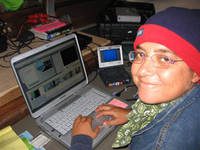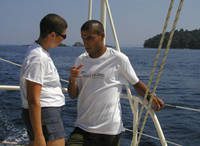May 3, 2005
Mar, like a modern Penelope. Tuesday, May 3th, 2005

In the open sea, at 350 miles from Bahamas, it was a remarkable sight to see flying fish jumping out of the water and glide over the surface, moving their fins so fast that they resembled a hummingbird. This morning, a tropicbird (Phaethon lepturus) came to visit, and returned in the afternoon. It is a beautiful bird of elongated tail, which would fly around the catamaran and then glide over it, as if looking for a place to land. Indi, the naturalist, consulted his species guide book to give us further information. Tropicbirds are called rabijuncos in Spanish, because their tails resemble a flexible plant called junco. They have relatively short legs, which makes it difficult for them to walk on land. This is why they go straight to their nests that they build over cliffs or ledges, from where they resume flight, being able to travel hundreds of miles into the ocean. How lucky! After this adult bird visit, a juvenile came to around. In this case, the feathers of the juvenile’s tail were fewer. In addition to the tropicbirds, we saw some petrels (Hydrobatidae), an exclusively a marine bird.
Now we are sailing with “choppy seas” comments Carlos, the first officer “and the foam that forms around the crest of the waves when they break are disappearing. It is a sign that calm is coming. Our navigation becomes very slow, advancing barely five knots, so Carlos, who was on guard duty at that point, decided to lower the sails and switch on the motors. The captain, who was resting, came out see what was going on.

Mar Mas, the camera person, takes advantage of navigation time to edit the film footage from the last few dives. She does this on a small makeshift desk in her cabin. Ricardo, one of the naturalists onboard, analyzes the underwater images with her. I tried to accompany them for a while, but I had to run out when I noticed the first symptoms of nausea.
Like a modern Penelope, every time Mar finishes a diving session, she organizes a “mini video editing room” in her cabin, which is located in the larboard hull. Afterwards, this operation has to be dismantled, otherwise she could not sleep. She spends hours and hours in the editing process, working in a reduced space measuring only one meter long by one meter wide. She uses a folding table which she places by her bed. In the daytime, she covers the hatch with a blanket to keep the sun from coming in, and her area has conditioning working to keep the equipment from overheating. When Mar edits her spectacular images, she has to wear clothes with warm lining and a hat that cover even her ears, it is that cold there. During this time, Indi cannot connect the “cooler” (refrigerator) where he keeps the sodas, because it is not convenient to overload the generator on the Ranger. Once in a while Mar comes on deck to take a break “And to see if I thaw out along the way”
She carefully keeps the video cassettes in a box with locks, with waterproof double O ring locking system and silicone bags to preserve them from humidity. Until now, and since the Expedition began, she has more than 70 tapes in Mini DV format, each one is an hour long. Most of them correspond to diving sessions. She is now almost finished with the film footage from Florida, from weeks ago and she is now going to start editing the Bahama footage. She has so much work ahead of her that the captain has decided to excuse her from guard duty. On this subject, my shift has been changed; it is now from 3 to 6, accompanying Carlos.

Mar Mas and the photographer Houssine Kaddachi make a first rate team. Houssine is French, 28 years old, of Tunician descent. He not only carries out his work shooting underwater photos, but he also assists Mar in doing her filming. They met three years ago when Mar traveled to Indonesia to film a documentary for the gobernment of that country. He was one of the divemasters assigned to her. Underwater, Mar needs a strong, capable person, able to endure holding the lighting equipment (“the Kowalski”) for hours at a time and even holding her in delicate and difficult balance maneuvers to keep from scaring off species. Houssine is not only a perfect technical assistant, but the very life of the producer depends on him. “He is my life insurance, what else can I say. We complement each other very well underwater and that is very important. I concentrate on recording and although I must be well aware of the surroundings, there are times when that is not possible. Houssine is always looking out for me, since we cannot speak, our communication is very intuitive”.
Today we started to sight sargassos, sporadically at first, but every time with more frequency. And we have seen floating debris as well: plastic material, a bottle, what seemed to be a piece of net, a buoy, and pieces of white Styrofoam…we can also count about twenty Portuguese Man-of –war (Physalia physalis), a fascinating animal, but we will tell more details on it tomorrow.

